![]()
![]()
![]()
Use LEFT and RIGHT arrow keys to navigate between flashcards;
Use UP and DOWN arrow keys to flip the card;
H to show hint;
A reads text to speech;
52 Cards in this Set
- Front
- Back

|
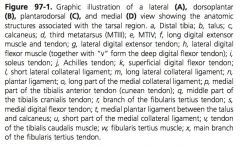
|
|
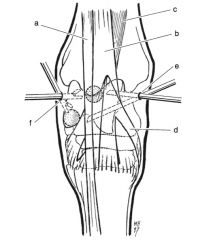
|

|
|
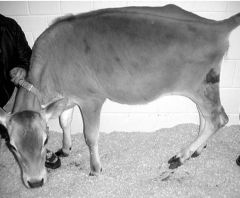
|
gastrocnemius rupture
|
|
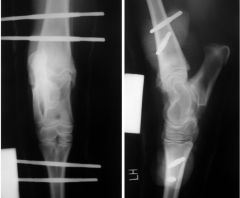
|
fixation of bovine gastrocnemius rupture with TPC, 2 pins in distal radius, 2 pins in proximal MT3
|
|
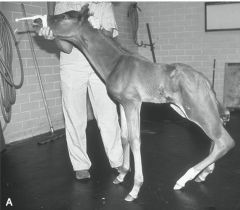
|
gastrocnemius rupture
|
|
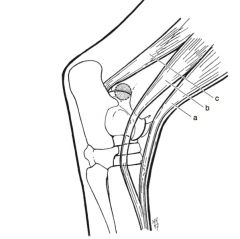
|

|
|

|

|
|
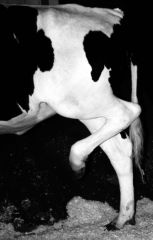
|
proximal intertarsal luxation
|
|
|
Origin and insertion of long collateral ligaments of tarsus:
|
originate on distal tibia, insert on proximal metatarsus with some attachments to the talus and small tarsal bones
|
|
|
Origin and insertion of short collateral ligaments of tarsus:
|
originate on medial or lateral malleolus cranial to origin of long, insert on talus and calcaneus
|
|
|
Joints of tarsus:
|
tarsocural, proximal intertarsal, distal intertarsal, tarsometatarsal, talocalcaneal
|
|
|
Facets of talocalcaneal joint:
|
medial aspect of calcaneus and talus; angulated coracoid facet at lateral aspect of calcaneus and talus; lateral aspect of calcaneus facing medially and medial aspect of talus facing laterally
|
|
|
Origin of fibularis (peroneal) tertius:
|
muscular (extensor) fossa of distal lateral femur
|
|
|
What forms the DDFT near tarsus?
|
Tibialis caudalis and lateral digital flexor pass over medial talus in tarsal sheath, distally the medial digital flexor tendon contributes but passes over the tarsal more dorsally than the other portions in its own sheath
|
|
|
Function of tarsus:
|
transform axial load during weight bearing from cranioproximal to caudodistal forces to vertical and distal forces
|
|
|
3 forms of tarsal OA:
|
distal tarsal joint, talocalcaneal, tarsocural
|
|
|
describe cunean tenectomy:
|
4 cm vertical incision over tendon approximately 5 cm dorsal to chestnut, 4 cm section of tendon is removed with scalpel blade
|
|
|
treatment of talocalcaneal OA:
|
arthrodesis of joint
|
|
|
examples of distal tibial fractures:
|
medial and lateral malleolar fractures
|
|
|
treatment of medial malleolar fracture:
|
arthroscopic removal, larger than 3cm fixed with 3.5, 4.5, 5.5 cortex screw or cancellous screw in lag
|
|
|
Treatment of lateral malleolar fracture:
|
arthrotomy over fragment or arthroscopic guidance with portals in dorsolateral and plantarolateral TC joint, larger than 3c, fixed with 3.5 cortex screw in lag
|
|
|
Most common locations for trochlear ridge fracture:
|
distal lateral and proximal medial
|
|
|
Treatment of trochlear ridge fractures:
|
arthroscopic removal of small fragments, large fragments fixed with multiple 3.5 cortex screws in lag, PDS pins, or cannulated screws through arthroscopy guidance or arthrotomy
|
|
|
Visualization with caudolateral TC arthroscopic approach:
|
most proximal aspect of talocalcaneal articulation, proximocaudal aspect of lateral trochlear ridge, caudal aspect of DIRT, medial trochlear ridge
|
|
|
Treatment of talus body fractures:
|
3.5 cortex screws in lag approached over fragment
|
|
|
Post-op care for trochlear ridge fracture:
|
rest 8-10 weeks after arthroscopic removal, 6-8 months with internal fixation
|
|
|
Treatment of sagittal fractures of the talus:
|
2-3 4.5-5.5 cortex screws in lag using arthroscopic visualization of joint surface
|
|
|
Radiographic view for calcaneal and sustentaculum tali fractures:
|
calcaneal skyline
|
|
|
Treatment of calcaneal fracture:
|
small fragments are left or removed by direct approach, large fragments repaired with lag screws, transverse fractures fixed with plate application to plantarolateral aspect of calcaneus
|
|
|
Prognosis for calcaneal fracture:
|
poor if involve buras or severe soft tissue disruption
|
|
|
Treatment for sustentaculum fracture:
|
removal through tenoscopic approach from tarsal sheath or direct approach, if involves significant portion of flexor surface repair with lag screws
|
|
|
Treatment of fractures of central and 3rd tarsal bone fracture:
|
prolong stall rest with non-displaced or minimally displaced, 1-2 3.5 or 4.5 cortex screws in lag placed through stab incisions
|
|
|
Post-op care for central and 3rd tarsal bone fractures:
|
4-6 months rest
|
|
|
Where do tarsal luxations occur?
|
Mostly at TMT or PIT joint
|
|
|
Treatment of tarsal luxation:
|
with fracture: open reduction and internal fixation (distal tarsal joint arthrodesis, arthrodesis of TMT/DIT/PIT; without fracture: full limb cast for 3 months
|
|
|
Types of SDFT luxation:
|
lateral displacement with disruption of medial retinaculum, medial displacement with lateral disruption, splitting of the SDFT with portion on either side of calcaneus
|
|
|
Treatment of SDFT luxation:
|
partial or intermittent stall rest can be tried but not good prognosis for return to activity; surgical repair with apposition of ruptured ends and mesh over the repair or if minimal retinaculum available anchor or suture screws are placed
|
|
|
Post-op care for SDFT luxation repair:
|
full limb cast for recovery, rest for 4-6 months
|
|
|
Cause of DDFT displacement:
|
congenital anomaly where DDFT is axial to normal position because of hypoplasia of the sustentaculum tali
|
|
|
Location of gastrocnemius rupture:
|
origin of muscle on distal and caudal femur
|
|
|
Treatment of gastrocnemius rupture:
|
full limb Robert jones +/- splint, or tube cast for 3 weeks followed by Robert jones for 3-5 weeks
|
|
|
Complications of gastrocnemius rupture:
|
complications relates to long term cast and bandage application
|
|
|
Locations of OCD in tarsus:
|
DIRT (1st), lateral trochlear ridge (2nd), medial malleolus (3rd), medial trochlear ridge (4th), lateral malleolus
|
|
|
Location of SCL in tarsus:
|
distal tibia, talus
|
|
|
Arthroscope portal for DIRT:
|
dorsal aspect of dorsomedial pouch, too medial can not pass over trochlear ridge, too proximal or too distal makes visualization more difficult
|
|
|
Arthroscope portal for MM OCD:
|
dorsomedial but more distal than for DIRT to avoid coming out of joint during visualization
|
|
|
Arthroscope portal for LTR OCD:
|
Dorsolateral portal has better visualization but dorsomedial approach preferred because better triangulation and better exploration of whole joint
|
|
|
Location of gastrocnemious injury in ruminants:
|
muscle attachment on femur, musculotendinous junction, tendon of insertion of calcaneus
|
|
|
Treatment of gastrocnemius rupture in ruminants:
|
cast or TPC with 2 pins in distal tibia and 2 pins in proximal MT3; maintained for 6-12 weeks with cast change in calves every 3 weeks and cast change in adults every 6 weeks; small ruminants a 6.5 cancellous or 7-7.3 cannulated screw is placed to fix the calcaneus to the distal tibia to lock it in extension then cast is placed
|
|
|
When is direct repair of gastrocnemius rupture indicated?
|
Only weight <350kg and with tendon lacerations
|
|
|
Treatment of PIT luxation in cattle:
|
closed reduction by traction applied distally and slightly caudally, stall rest for 6 weeks
|
|
|
Complication of closed reduction of ruminant PIT luxation?
|
Small fracture of the proximal dorsal tip of the calcaneus
|

